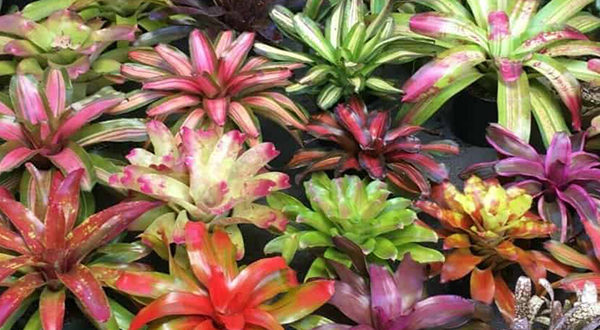Common Name: Bromeliad
Scientific Name: Bromeliad genera
Type of Plant: Perennial
Description: The term “bromeliad” refers to thousands of species of plants in hundreds of genera in the plant family Bromeliaceae. These relatives of the common pineapple are available in an astonishing array of colors and textures. Although many do have very showy flower displays, bromeliads are just as popular as beautiful foliage plants with strappy leaves in red, green, purple, orange, and yellow colors and with bands, stripes, spots, and other features.
Mature Size: Varies according to genera and species
Blooms: Blooms once, timing varies
Fruit: No
Climate Requirements: Bromeliads need in-direct sunlight to grow well and produce flowers, with a few exceptions.
Care Requirements: Bromeliads are either terrestrial or epiphytic in their natural habitat. Terrestrial bromeliads require soil for growth, like most plants.
Epiphytic bromeliads do not live in soil but survive by clinging to a tree or other supports such as rocks. Epiphytes are not parasites. They do not harm the host plant in any way, but merely use them for support. Epiphytes obtain all their water and mineral needs from the environment. Epiphytic bromeliads can be grown like a terrestrial one; however, understand the potting mix is insignificant.
Proper drainage is essential. The soil mix must be porous enough to allow water to drain off quickly and allow air to reach the roots. It should never be soggy.
Spacing: Varies according to genera and species
Water Needs: Water bromeliads well and allow the soil to dry before watering again. Many bromeliads hold water in a leaf cup called a “tank.” The tank should be kept filled with water at all times. Be careful when you fill the tank, not to let the water soak the soil. Bromeliads are prone to root rots if the soil is kept wet. Flush the tank periodically by pouring fresh water into it, inverting, and filling again. This will prevent stagnation and buildup of mineral salts.
Maintenance: These are vigorous-growing plants that can quickly take over a wall or garden area, but can be trained and maintained to fit a desired setting. Bougainvillea can also be used in containers and trained as a shrub or sprawling groundcover.
Special Uses/Attributes: Bromeliads are fairly long-lived and slow-growing plants. Although the central plant dies after flowering, they produce “pups” that can be separated and potted up to form new plants.
Florida Native: Some species are native to Florida

